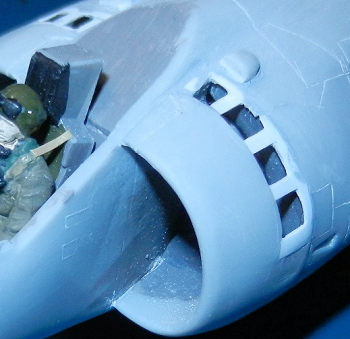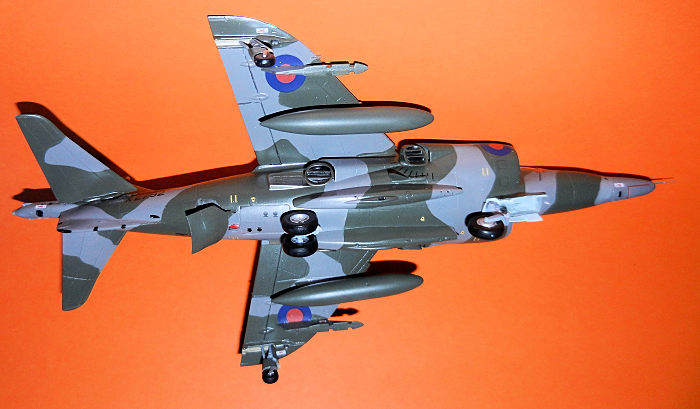
| KIT #: | 5102 |
| PRICE: | Can$3.79 'used' |
| DECALS: | One option |
| REVIEWER: | Pablo Calcaterra |
| NOTES: | 1991 release |

| HISTORY |
This particular Harrier XZ972 has a couple of first: the first RAF Harrier to land on HMS Hermes during the deployment of 1 Sqn RAF during Operation Corporate, and the 1st RAF Harrier shot down during the war.
In March 1982 1 Sqn led by Peter Squire was training in Tromso, Norway during a standard exercise for a potential conflict with the Soviet forces. On April 8th they were told to get ready to fight in the upcoming war in the South. The role of the RAF Harriers was to replace the high losses expected to be suffered by the RN FRS1s.
On March 29 1982 XZ972 was part of 233 OCU at RAF Wittering (coded L). Early April it was transferred to 1 (F) Sqn where it became Red 33 (on the tail with yellow 33s on the outriggers). Navalisation included sealing panels against salt water, fitting shackles to the outriggers to permit lashing the aircraft to the deck, and the embodiment of an I-Band transponder to permit recoveries to the carrier in bad weather. In less than 3 weeks the GR3s were readied and certified to use air to air missiles. Later modifications (not to XZ972) included the installation of an I-Band jammer, a flare and chaff dispenser and the ability to carry and fire both LGBs and American ARMs. The rest of the time was used to train the pilots on the use of the I-Band transponder, ski jump, use of the air to air missiles and practice dogfights against French Mirage III and SUE (as their NATO allies also passed the British information about the training and tactics the Argentines had received from the French)
On April 30 XZ792 was sent to RAF Valley to test fire Sidewinders AIM-9G missiles. From RAF Wittering it flew on RAF St Mawgan on May 2nd and the following day to Wideawake in Ascension Is.
On May 6 along with the other 5 GR3s it hopped to Atlantic Conveyor starting the trip south one day later. Having flown directly from the UK to Ascension island the Harriers landed in the container ship Atlantic Conveyor converted in a de facto aircraft transport with limited plane carrier capabilities (a FRS1 was kept on permanent alert in case this group of ships of the Task Force was threatened by the Argentines). The 10 days it took for the ship to reach the TEZ was used to continue training and getting ready for the shooting war to come.
On May 18th Wing Commander Peter Squire flew XZ972 to HMS Hermes thus becoming the first RAF Harrier to land on the carrier. Upon landing on HMS Hermes they found a quite hostile mood towards RAF which was instigated by the plane carrier’s Captain Middleton. It was said that he was fighting 3 wars: The first against the RAF, the second against Admiral Woodward and the 3rd and last against the Argentines.
The first mission of the RAF Harriers took place on May 20th (a recco mission).
On the 21st and to support the landings at San Carlos a couple of RAF Harriers were ordered to do an armed recco with targets to be assigned by HMS Antrim. It was supposed to be a 2 plane mission but Wing Commander Squire’s plane had a mechanical problem and his #2 Jeff Glover was went ahead alone in XZ972. This was a big No-No rule that had been strongly agreed by the pilots and was broken to the surprise of many. He climbed to 20,000 ft awaiting for a target to be assigned. When nothing significant was found he was told to try to bomb some Argentine positions at Port Howard.
 This place
had received a section of Compania 601 de Comandos from the Argentine Army two
days earlier. They were to do exploration and set the main AAA defense for
Howard (with heavy machine guns of 12.7 mm of the other Army units already in
the area being the only ones till then). From their positions just across San
Carlos the Argentines could see the incessant movement of British helicopters.
They realized the Task Force had finally made their move. At approximately 9.45
am they head a jet plane approaching Howard from the southeast at approximately
20 ft over the water. It was Glover. The commandos had established an AAA trap
made up of 3 pairs with Blowpipes facing the Sound just 150 mts from the shore.
The pairs were 20 meters apart. Ehen he was ingressing and unbeknown to Glover
the Commandos fired 2 missiles at him. The Blowpipes flew roughly 3,000 mt
parallel to each other at extreme range. A providential change of direction of
Glover fooled the missiles that exploded on the ground on the opposite side of
the bay. When Glover flew over the target he realized that it was too close to
the settlement and civilian casualties were a risk. So he aborted his attack and
told so to HMS Antrim. As there were still no other targets available Glover
suggested taking some pictures of the target area. HMS Antrim agreed.
This place
had received a section of Compania 601 de Comandos from the Argentine Army two
days earlier. They were to do exploration and set the main AAA defense for
Howard (with heavy machine guns of 12.7 mm of the other Army units already in
the area being the only ones till then). From their positions just across San
Carlos the Argentines could see the incessant movement of British helicopters.
They realized the Task Force had finally made their move. At approximately 9.45
am they head a jet plane approaching Howard from the southeast at approximately
20 ft over the water. It was Glover. The commandos had established an AAA trap
made up of 3 pairs with Blowpipes facing the Sound just 150 mts from the shore.
The pairs were 20 meters apart. Ehen he was ingressing and unbeknown to Glover
the Commandos fired 2 missiles at him. The Blowpipes flew roughly 3,000 mt
parallel to each other at extreme range. A providential change of direction of
Glover fooled the missiles that exploded on the ground on the opposite side of
the bay. When Glover flew over the target he realized that it was too close to
the settlement and civilian casualties were a risk. So he aborted his attack and
told so to HMS Antrim. As there were still no other targets available Glover
suggested taking some pictures of the target area. HMS Antrim agreed.
Waiting for a follow up the Commandos heard what they thought was a second plane (it was Glover again) 5 minutes later. Glover was flying in from exactly the same direction as the first time (though he claims he approached the area flying from a different direction). He had no element of surprise. This time the Argentine trio allowed the plane to get closer to them and the Blowpipes were fired with the plane about to pass by their position. One of the missile’s direction systems was U/S so Capt Frecha directed it towards the ground. 1st Lt Sergio Fernandez’s missile exploded by the Harrier. At first Fernandez was disappointed as, from the cloud of the explosion the nose of the Harrier came out. And the plane seemed to be untouched. Glover later said that it felt like the plane was flying thru hail and then it caught fire. The plane did a 360 over her axis (witnesses on the ground later told him that the Harrier had lost more than half of the right wing). The pilot looked down into the cockpit, pulled the ejection handle with his right hand while the left one was still holding the throttle (thus the injuries he sustained). The commandos witnessed a bit of smoke coming out of the Harrier and the pilot ejected. By now everyone was firing their guns at the RAF plane. While Glover was floating in his parachute towards the water his plane crashed on the ground and while disintegrating decapitated a horse in a field. Glover hurt his face and broke his left shoulder, arm and collarbone during the ejection. He landed in the very cold water and in his confused state tried to swim towards the shore dragging his parachute (an impossible task). In the meantime the Commandos rushed to the coast where 2 non-commissioned officers jumped into a rowing boat and rescued Glover from the water. Capt. Llanos (the Commando’s medic) took care of Glover who had trouble speaking due to the shock and the cold immersion.
After inspecting the
remains of the plane Fernandez took the compass of the plane and brought it with
him to the continent after the end of the war as a war trophy. That night Glover
gave his own blood to help during a surgery of an injured Argentine soldier
because “any other soldier that would have given his blood would have badly
needed it during their patrols out in the open in the middle of the cold night”.
The  Argentines
were very glad with the comradery demonstrated by Glover. At the same time the
British pilot was nicely surprised that he was not being forced to divulge any
military information beyond the Geneva Convention one.
Argentines
were very glad with the comradery demonstrated by Glover. At the same time the
British pilot was nicely surprised that he was not being forced to divulge any
military information beyond the Geneva Convention one.
The very same May 21st the RATONES section of the Fuerza Aerea Argentina were shot down during their run in to attack the Task Force at San Carlos Water. One of the pilots that were recovered on the 22nd was RATON 2 Mayor Gustavo Piuma Justo (for more see here). He also suffered injuries during his ejection.Both pilots were recovered to Stanley/Puerto Argentino thru Darwin (still in Argentine hands) in a Bell 212 of the Argentine Air Force. During the risky transfer (as the British forces were between Howard and their destination) Glover desperately and anxiously communicated with his hands to the helicopter pilots to fly further south (away from the British ships and ground troops). Capt Llanos was taking care of him. Because of his injuries Glover asked Llanos that, in case they fell into the water (shot down) he would allow him to hold on to the Argentine’s backpack because he would not able to swim with his injured shoulder. To which Llanos answered: “If I’m still alive…” and Glover retorted: “What a black sense of humour you have!” After a short stay in Darwin they continued their flight to the capital of the islands. When they were approaching it in the evening of the 23rd Glover asked Llanos what where those lights in the distance. After hearing the answer of the medic (“Puerto Argentino for me, Stanley for you”) Glover exclaimed: “What a shit(y place)!” Llanos told him that they were fighting for principles but Glover answered that: “This war makes no sense. It is a political one. “Gualtiero” and Thatcher. And I am following orders the same as you are”.
When Glover was about to be handed over to the Army in the capital he told Llanos to take his survival knife as he wanted to thank him and keep it as a memento…with the condition that Llanos was going to send him his after the war.
Thus they landed safely in the Argentine airfield. On May 25th and to his surprise (as he was under the impression that the TEZ was being satisfactorily imposed) Glover was flown to the continent in a C-130 during one of their numerous night missions that broke the TEZ. From Comodoro Rivadavia (where he stayed a few days and received the visit of some Argentine pilots) he was flown to Buenos Aires where he remained for almost 5 weeks.
On July 8 1982 and having mostly recovered from his injuries Jeff Glover was returned to the UK. In 2007 later he found the medals he was awarded in a drawer at home and auctioned them (Queen’s Commendation for Valuable Services in the Air – Mentioned in Dispatches). (Contrary to many statements Jeff Glover was not the only British POW. During a SAS mission that was discovered by the Argentine troops the leader was killed in combat and his companion was taken prisoner).
By May 30 out of the 6 original GR3s there was only one plane operational. On June 8 the RAF received 4 Harriers as reinforcements flown directly from Ascension Island.
In all RAF Harriers flew 126 operational attack or recco sorties from May 20th till June 14th. From my point of view the most relevant ones are the destruction of the generators used by the 35mm batteries in Goose Green that allowed these weapons to be neutralized and reduced the opposition to 2 Para on May 28th, the destruction of the Chinooks (thus significantly affecting the mobility of the Argentine forces) by the section led by Sqn Ldr. Jerry Pook on May 21st , and the first successful launch of laser guided bombs on the last day of fighting (after many unsuccessful drops due to technical issues). Many bombs were toss dropped on the runway in Puerto Argentino/Stanley without success. Several attacks with cluster bombs and rockets varied in their effect.
Of the 10 GR3s that fought in the South Atlantic 3 were shot down, 8 damaged (one of these was later shot down and another one was CAT5 after a crash landing at FOB San Carlos). Some were made operational again with duct tape, putty or even a change of engine in one occasion. By June 14th when the Argentines ceased fighting (there was a cease fire and not a surrender) there were 3 GR3s in service on HMS Hermes (There were 4 other Harriers available in a ship but these were not put in action). A very significant attrition rate.
| THE KIT |
 Airfix
released their Harrier in 1/48 in 1998. From my point of view an opportunity to
best the earlier Monogram was wasted. There are many areas that require changes
or fixes and I will dwell on these below.
Airfix
released their Harrier in 1/48 in 1998. From my point of view an opportunity to
best the earlier Monogram was wasted. There are many areas that require changes
or fixes and I will dwell on these below.
Decals are decent but printed in a “sloppy” way. Some of the ink seems to have run a bit and therefore the fonts for the stencils are not sharp.
There are two drop tanks, 4 rocket launchers (I used two of these on the Monogram GR1)..
| CONSTRUCTION |
When I purchased the kit on eBay several years ago my idea was to kit-bash it with the Airfix GR3 with the Monogram GR1 like many others have done. That is to say use the nose of the GR3 and attach it after some surgery to the Monogram kit. I wanted to build a 1982 South Atlantic RAF Harrier.
Several ideas crossed my mind in terms of what to do with the unused Airfix Harrier (minus nose) and a discarded GR1 Monogram pointy nose. Maybe a diorama with Peter Squire’s crashed Harrier at San Carlos. Or a Spanish Armada Matador…and then I decided to kill the kit-bash project and build the two kits independently. The Monogram would be a GR1 and the Airfix a GR3.
First thing (just to complicate my life, like always) was to re-scribe all the panel lines and eliminate the raised panel lines. Vortex generators on the wings were thinned out with a Xcto knife making vertical cuts.
The nose wheel well is just a flat area with no detail whatsoever. I took the Monogram halves, made a cast with Bluetac and then created some copies with 2 part epoxy. There were far from perfect and required some plasticard and bending to make them work decently. This new nose wheel bay was attached to one fuselage half after I finished with the other major surgery required to fix this kit.
 Following
the directions of the Harrier SIG I removed the intakes walls. This was also
necessary because of the new wheel wells mentioned above which were preventing
the fuselage halves from closing. I had to sand a lot of epoxy in order be able
to sit the new profiled intake walls made of pieces of Evergreen. The bell-mouth
had to be cut short a bit. The support for the center of the engine was made
with a bomb that was cut and sanded. Triangles of plastic covered the gap
created by this surgery between the fuselage and the intakes. After careful dry
fitting of the turbine blades and the new walls (with a considerable amount of
putty to cover the gaps) this area was ready for installation.
Following
the directions of the Harrier SIG I removed the intakes walls. This was also
necessary because of the new wheel wells mentioned above which were preventing
the fuselage halves from closing. I had to sand a lot of epoxy in order be able
to sit the new profiled intake walls made of pieces of Evergreen. The bell-mouth
had to be cut short a bit. The support for the center of the engine was made
with a bomb that was cut and sanded. Triangles of plastic covered the gap
created by this surgery between the fuselage and the intakes. After careful dry
fitting of the turbine blades and the new walls (with a considerable amount of
putty to cover the gaps) this area was ready for installation.
I put some lead ballast was added to the nose. The instrument panel is a decal I made using a picture of the actual thing I found on line. The cockpit was painted using the colours indicated by the SHAR Special Interest Group of the IPMS UK (Dark Sea Grey).
 The
auxiliary doors on the top portion of the air intakes are open when the Harriers
are on the ground. Thus I had to cut out the top portion of the back of the
intake and replaced it with a thin strip of Evergreen where I had cut out the 4
doors. These themselves I made with more of the same plastic and were attached
in a dropped position at the end of the building process. The other doors were
scribed as Airfix only represents them as dents…
The
auxiliary doors on the top portion of the air intakes are open when the Harriers
are on the ground. Thus I had to cut out the top portion of the back of the
intake and replaced it with a thin strip of Evergreen where I had cut out the 4
doors. These themselves I made with more of the same plastic and were attached
in a dropped position at the end of the building process. The other doors were
scribed as Airfix only represents them as dents…
There are several holes, access panels, etc that are missing in the kit. I drilled these very carefully (Hot air outlet in tail, RCV vents on the wings, camera on the nose)
The interior of the airbrake was scratchbuilt with Evergreen strips copying the structure present in the Monogram kit. The airbrake itself is too short and has to be extended with plasticard.
There is a large gap ahead of the nozzles inside the fuselage. I glued some plastic card painted in black to cover these (else you can see the light shinning thru the cockpit…). I sanded the nozzles a bit to reduce the chunkiness look they have.
Shape and length of the heat shields behind the back nozzles is completely wrong. I cut these parts out and then was left with some large holes. Plasticard and putty to the rescue. A couple of new heat shields were made with bent plasticard and engraved per the SIG directions.
At this stage I realized that the GTS/APU exhaust and the GTS/APU intake and vent are just raised panel lines. I drilled it out the exhaust and used plasticard to give it the proper angle. The intake and vent was copied from the Monogram GR1 using my now usual technique with Bluetac and 2 part epoxy. With some putty and sanding this one was installed. Because of this the intake and vent is slightly sticking out and not flush with the surface. Still…I believe it is better and nothing and better than having to create the grid with a knife or similar.
MDC explosive detonator covers behind the cockpit were scratchbuilt. The fuselage halves with the new nose wheel bay, nose weight, cockpit, pilot and nozzles were glued together. Some putty was required in some places to improve the fit. Windshield was glued in place improving the fit with putty. I added some seatbelts from the seat to the pilot with masking tape. The canopy was attached and it structure improved by using putty and making cuts on the top of the air intakes to represent the canopy intake fillet fairings.
The wings were attached and their fit and alignment is (maybe not surprisingly) bad. The curvature of the top side of the wings is more pronounced than the contiguous fuselage surface and therefore a significant amount of sanding had to be done (front and back of the fuselage portion, center of the wings). With a couple of tiny round section parts from the spares box bent upwards the fuel dump pipes were created.
 The tail
area requires several changes: to present them dropped like in real life I cut
the inserts till the horizontal surfaces could be turned inside the
slot/attaching point. The bulges on top of the fuselage close to the tail
sealing plates and these plates were also fabricated with evergreen plastic.
The tail
area requires several changes: to present them dropped like in real life I cut
the inserts till the horizontal surfaces could be turned inside the
slot/attaching point. The bulges on top of the fuselage close to the tail
sealing plates and these plates were also fabricated with evergreen plastic.
The gun pods are missing some vents (that I drilled) and plates (more Evergreen). The front of them is quite basic so I drilled open the 30 mm muzzles. The front also has a squared profile instead of rounded (so I sanded it to a more decent shape). Outriggers and nose wheel need the shackles that I made with tiny pieces of plastic and thin wire.
Anti-collision beacons are copies from the Monogram kit made with 2 part epoxy. Other minor details are the the wrong shaped (and missing) UHF antennas (too small in the kit), the I-Band transponder under the nose, an oversized IFF antenna just ahead of the cockpit and the undersized conditioning system ram air takes.It was a massive undertaking. After giving the kit a nice wash with mild soap the Harrier was ready for painting.
| COLORS & MARKINGS |
For the first time ever I used Vallejo grey primer. (I had used the ModelMaster Acryl one in the past). WHAT A DIFFERENCE! This premier glued itself to the plastic…like it was part of the plastic! I am never using the ModelMaster primer again.
Canopy and windshield frames were masked and painted black followed by the cammo colours. First I painted most of the plane with grey (Vallejo 991-159). Using the Airfix scale plans, taking them to 1/48 and cutting out the grey areas I used masking tape to cover this colour. Notice that on the left right side of the nose there seem to be two tones of grey so I diluted the paint a bit with white to recreate these differences. The green (Vallejo 893-095) was then safely applied with the airbrush. Airbrake interior was painted ModelMaster Acryl 4754.
 A mix of
rust and green paint was brushed around several of the inspection doors per
pictures of the real plane. With the entire landing gear system glued in place I
proceeded to give the Harrier roughly 3 coats of Future.
A mix of
rust and green paint was brushed around several of the inspection doors per
pictures of the real plane. With the entire landing gear system glued in place I
proceeded to give the Harrier roughly 3 coats of Future.
Everything was now ready for the decals.
The decals are quite decent but not great. For this 1 Sqn Harrier I designed my own “Red 33” for the tail and outriggers. I also printed a couple of “2” for the XZ792 (the first 4 came from the kit with the 9 being originally a 6). Tiny strips of red decal were positioned around the I-Band transponder.
I had scanned the two large decals that have the angle of the front nozzles because the Monogram kit does not have them. The ones from Airfix were used in the Monogram Harrier and the copies I made in the Airfix one because any imperfection of my copies would be less visible against the colours of the GR3. All decals reacted very well to Set and Sol solutions.
More mix of rust and green was used for top wing roundels painted over some panels. Thin red decals from the spares were used to represent the tape sealing the I-band nose transponder. A tiny dotted white decal was used to represent the markings on the doors of the laser pointer. Once these were dry I sealed the decals with ModelMaster Semigloss varnish.
| FINAL CONSTRUCTION |
 I started
to add the details for the bottom fuselage from the center and moving outwards:
landing gear doors, airbrake (with scratchbuilt actuator), drop tanks. For the
top I made my own the temperature probe on the tail, the direction vane (painted
in orange), a new thinner IFF antenna, and a few other details. The nose camera
was painted in black and the undersized pitot tube was replaced with another one
from the spares box.
I started
to add the details for the bottom fuselage from the center and moving outwards:
landing gear doors, airbrake (with scratchbuilt actuator), drop tanks. For the
top I made my own the temperature probe on the tail, the direction vane (painted
in orange), a new thinner IFF antenna, and a few other details. The nose camera
was painted in black and the undersized pitot tube was replaced with another one
from the spares box.
The navigation/formation lights were painted in 2 steps: Vallejo Aluminum followed by Clear Red and Green from ModelMaster. Two small blobs of clear plastic were attached to the tail to represent the navigation lights.
I used fine strips of white decal paper around the edge of the Plexiglas.
| CONCLUSIONS |
I am pretty sure that Airfix will release an (much) improved version of their GR3 in the near future. This one is a good starting point and it is up to the modeller to decide how many modifications he will be willing to endure to improve it.
I cannot finish this review without thanking the help of Nick Greenall of the Harrier SIG of the IMPS UK. Thanks for your patience and support Nick!
| REFERENCES |
10 March 2020
Copyright ModelingMadness.com
If you would like your product reviewed fairly and fairly quickly, please contact the editor or see other details in the Note to Contributors.
Back to the Main Page Back to the Review Index Page Back to the Previews Index Page